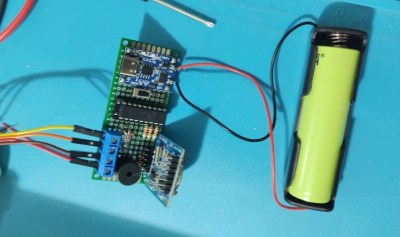It might seem antiquated, but Morse code still has a number of advantages compared to other modes of communication, especially over radio waves. It’s low bandwidth compared to voice or even text, and can be discerned against background noise even at extremely low signal strengths. Not every regulatory agency requires amateur operators to learn Morse any more, but for those that do it can be a challenge, so [Cristiano Monteiro] built this clock to help get some practice.
 The project is based around his favorite microcontroller, the PIC16F1827, and uses a DS1307 to keep track of time. A single RGB LED at the top of the project enclosure flashes the codes for hours in blue and minutes in red at the beginning of every minute, and in between flashes green for each second.
The project is based around his favorite microcontroller, the PIC16F1827, and uses a DS1307 to keep track of time. A single RGB LED at the top of the project enclosure flashes the codes for hours in blue and minutes in red at the beginning of every minute, and in between flashes green for each second.
Another design goal of this build was to have it operate with as little power as possible, so with a TP4056 control board, single lithium 18650 battery, and some code optimization, [Cristiano] believes he can get around 60 days of operation between charges.
For a project to help an aspiring radio operator learn Morse, a simple build like this can go a long way. For anyone else looking to build something similar we’d note that the DS1307 has a tendency to drift fairly quickly, and something like a DS3231 or even this similar Morse code clock which uses NTP would go a long way to keeping more accurate time.
















Does this really serve as a learning device? Hams need to train their ears and not their eyes.
It has a speaker on the PCB
This seemed like a way to maybe condition your brain to hear and decode Morse even as background noise. So, I guessed that the Hackaday author must have just missed emphasizing the audio aspect. Then I watched the video and said to myself, “So, the passing-train-rumble-like noise on the video is Morse code? Is it, like, really slowed down or something?”
Nope. I was wrong on all counts. Per the linked LinkedIn article: “The idea was to produce a very simple, straightforward device that would tell the time using morse code and not annoy people around, so an audible dit/dah was out of question, but not a light-based one”
(Has LinkedIn become a common place for people to post projects?)
There are a number of ways to implement an audio tone on this project: in software software, or an audio oscillator triggered by the lamp lead(fare I say a 555?). Or this oriject could be developed as a smartphone or PC app.
Hi! Author here. The initial idea was something that I could keep over my desk at work so I could, somehow, exercise a bit of Morse code. Audible signals were out of question since it would annoy my colleagues. So, decided to give a shot at a visual only Morse code device.
Thanks.
– Cristiano
It would also be useful to have the clock spell the time alphabetically as well as presenting it numerically. I agree that listening to CW is a quite different from looking at it. I had to laugh at myself because I have operated CW, sending with a J-37 straight key on air for a long time, but still, following the flashing in the video was tricky because I am not accustomed to the visual pathway. This is still a nice project regardless.
Might be fun for a watch.
Like this? https://www.youtube.com/watch?v=DW1XwRxbSos
Well there goes my kickstarter.
Not to knock Morse Code, but today’s text modes can be decoded when the signal isn’t audible, have narrower bandwidth and can be stacked on top of each other at less than 20 Hz spacing.
It tends to be hard to understand CW spaced at 200Hz.
That has occurred to me also, but the singular advantage of Morse-type codes is that they do not require a computer of some sort to decode the data stream
; it’s done in “wetware”.
An interesting intermediate is “coherent CW,” which uses precise timing for the Morse elements. It’s roughly the Morse equivalent of FT8 and is compatible with “by ear” reception.
Nobody need arduino to learn morse code. Single 555 is more than anough but PC is even better. There is great software for learning without thinking about dash and dot. Young people learn CW as melody already at speed like in contests.
But on this site they want to sell arduino for projects where two transistors and few pasive components can be better.